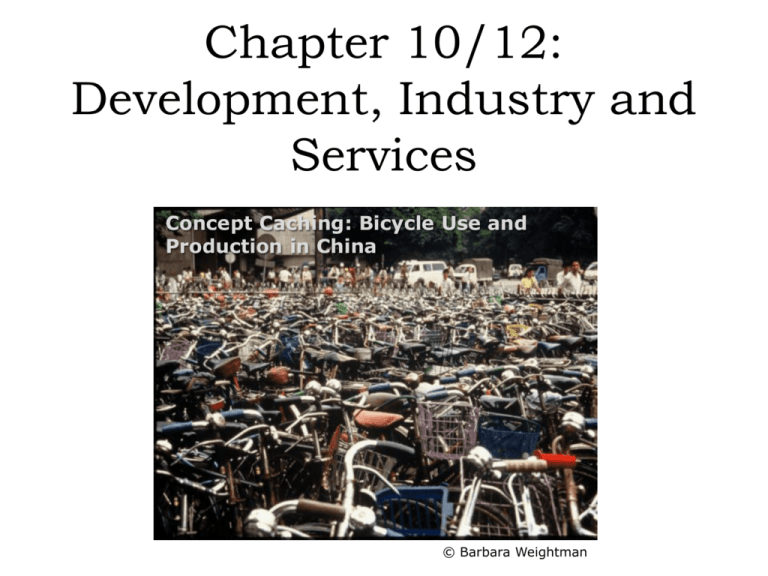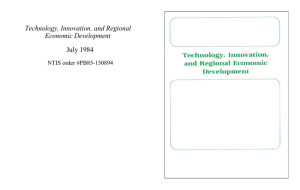HG-10 - A Virtual Field Trip of Physical Geography in Ventura County
advertisement

Chapter 10/12: Development, Industry and Services Concept Caching: Bicycle Use and Production in China © Barbara Weightman How Development Is Defined and Measured • Developing country: is making progress in technology, production, and socioeconomic wellbeing. – Wealth depends in large part on how and where it is produced, as well as what is produced. • Measuring development - 3 major areas of concern: 1. economic welfare. 2. technology and production. 3. social welfare. Gross National Income • GNP = a measure of the total value of officially recorded goods and services produced by a country in a given year, includes outside goods/services. – Gross domestic product (GDP) = measure of goods and services annually produced within the country. • Gross national income (GNI): monetary worth of what is produced within a country plus income received from investments outside the country minus income payments to other countries. – Per capita GNI = average income per person. *Political and Economic Influences – national government policies, big business encouraging urban development, and groups facilitating rural microcredit loans. • United Nations Human Development Index: economics + a long and healthy life, knowledge, and a decent standard of living. – Stats include per capita GDP, literacy rates, school enrollment rates, life expectancy at birth, etc. Barriers to and Costs of Economic Development Millennium Development Goals: 1. 2. 3. 4. 5. 6. 7. 8. Eradicate extreme poverty and hunger. Achieve universal primary education. Promote gender equality and empower women. Reduce child mortality. Improve maternal health. Combat HIV/AIDS, malaria, and other diseases. Ensure environmental sustainability. Develop a global partnership for development. Barriers to Economic Development • • • • Social Conditions Foreign Debt Disease Political Corruption and Instability Costs of Economic Development • Industrialization • Agriculture • Tourism The Industrial Revolution • 18th-century inventions - new uses for energy sources (coal), machines to improve efficiencies (railroad and steam ships), iron manufacturing (many products), expanding trade. • Great Britain with great advantages at beginning of the Industrial Revolution. Diffusion and Production • Primary industrial regions: western Europe, eastern North America, western Russia and Ukraine, and East Asia. • Fordist period: the dominant mode of mass production (1945 to 1970) named for Henry Ford. • Major surge in both mass production and mass consumption. • Economic and cultural shift of commodification (Ex. USA public demand for goods). • Least cost theory: factories reduce production cost through changes in transportation, labor, and agglomeration (ex. New York City’s Textile Factories). Made in America vs. Designed in America • Commodity Chain: Consumption, or purchasing an item, is the end point in a commodity chain that affects places in a variety of ways. Where electronic materials are from… Major Influences on Contemporary Geography of Manufacturing • Transportation and intermodal connections. • Regulatory Circumstances and regional trade organizations. • Energy supply and industrial locations. New Centers of Industrial Activity The Rise of East Asia and China • ‘Four Tigers’ = South Korea, Taiwan, Hong Kong, and Singapore. – Hong Kong became mainland China’s gateway (bustling port, financial center, and break-of-bulk point). – China’s major industrial centers: Northeast district (heartland basin of the Liao River), Chang Jiang district (Shanghai port city). – China’s large labor force has attracted hundreds of international companies. • BRICS: Brazil, Russia, India, China, and South Africa; these countries are evidence of a shift in global economic power away from the traditional economic core. Field Note “Humen is one of the Pearl River Delta cities that has been transformed by the rise of China. The small textile factory I visited provided insights into the opportunities and challenges that are confronting China today. The 40 or so employees were mostly young, but there were a few older folks. They were making women’s clothes for the French market.” Deindustrialization, Service Industries and Production • Service industries (tertiary industries) encompass the range of services that are found in modern societies. – Includes: the collection, processing, and manipulation of information and capital; and activities that facilitate complex decision making and the advancement of human capacities. Geographical changes of Service Economy • Disparities between core and periphery have long characterized the global economy. • USA’s primary industrial zone (North American Core) in the northeastern United States lost industrial base/jobs (now called the Rust Belt). • The Sun Belt is a secondary industrial region that has made the transition to a viable service economy fairly successfully. New Patterns of Economic Activity • Technologies such as GIS can help to model the best locations for new businesses, office complexes, government centers, or transportation connections. • Major retailers change the economic prospects and physical landscapes of the places where their headquarters are located. Ex.: Walmart. • The locational influences on info/capital services are more diverse. • People who work in decision making/human capacities sector tend to be concentrated around governmental seats, universities, and corporate headquarters. Guest Field Note Fayetteville, Arkansas “For most geographers, the simple act of daily observation of the world around them becomes a profoundly satisfying habit. For the last 17 years, my daily observations have been of the rapidly changing urban/economic landscape of northwest Arkansas, one of the fastest growing metropolitan areas in the United States.” Credit: Fiona M. Davidson, University of Arkansas Figure 12.18 Fayetteville, Arkansas. High-Technology Clusters • Goal of a high-technology corridor: to attract designers of computers, semiconductors, telecommunications, sophisticated medical equipment, etc. (Ex.: California’s Silicon Valley) • Growth and technopole spurred economic development in urban and surrounding areas. • High-technology industries have become such an important symbol of the postindustrial world that local, regional, and national governments often aggressively pursue firms in this sector. Plano-Richardson, Texas. The Plano-Richardson Telecom Corridor is located just north of Dallas and is home to telecom corporate headquarters, such as Electronic Data Systems Corp headquarters in this photograph. Tourism Services • The tourism boom: began in the global economic core as incomes and leisure time increased for the local population. • • Tourism likely to continue/expand despite dips in travel during the first decade of the 21st century (recession). The economic impacts of tourist-related development are far-reaching. • Big-business Tourism vs. Eco-Tourism If given a choice, which would you support? Place Vulnerabilities in Service Economy • Mechanization can have a negative impact on service jobs. • Places dominated by the service sector cannot exist without extensive connections with other places (labor needs food, housing, and material products). • Economic decision making in a globalized economy can easily become disconnected from the fate of individual places and regions. – Example: the Financial Services Industry. • Bank subprime mortgage loans cause an economic disaster! • USA’s housing market collapse (2008). • Long-term financial, social, political ramifications. Homework Read textbook ch.10/12 Homework: Choose one “Thinking Geographically” topic in Ch.10 or Ch. 12 textbook and answer (1 page). OR Choose an important modern economic topic to research and summarize findings. Possibly a business, industry, or labor group as an example. List global influences (benefits and consequences).





